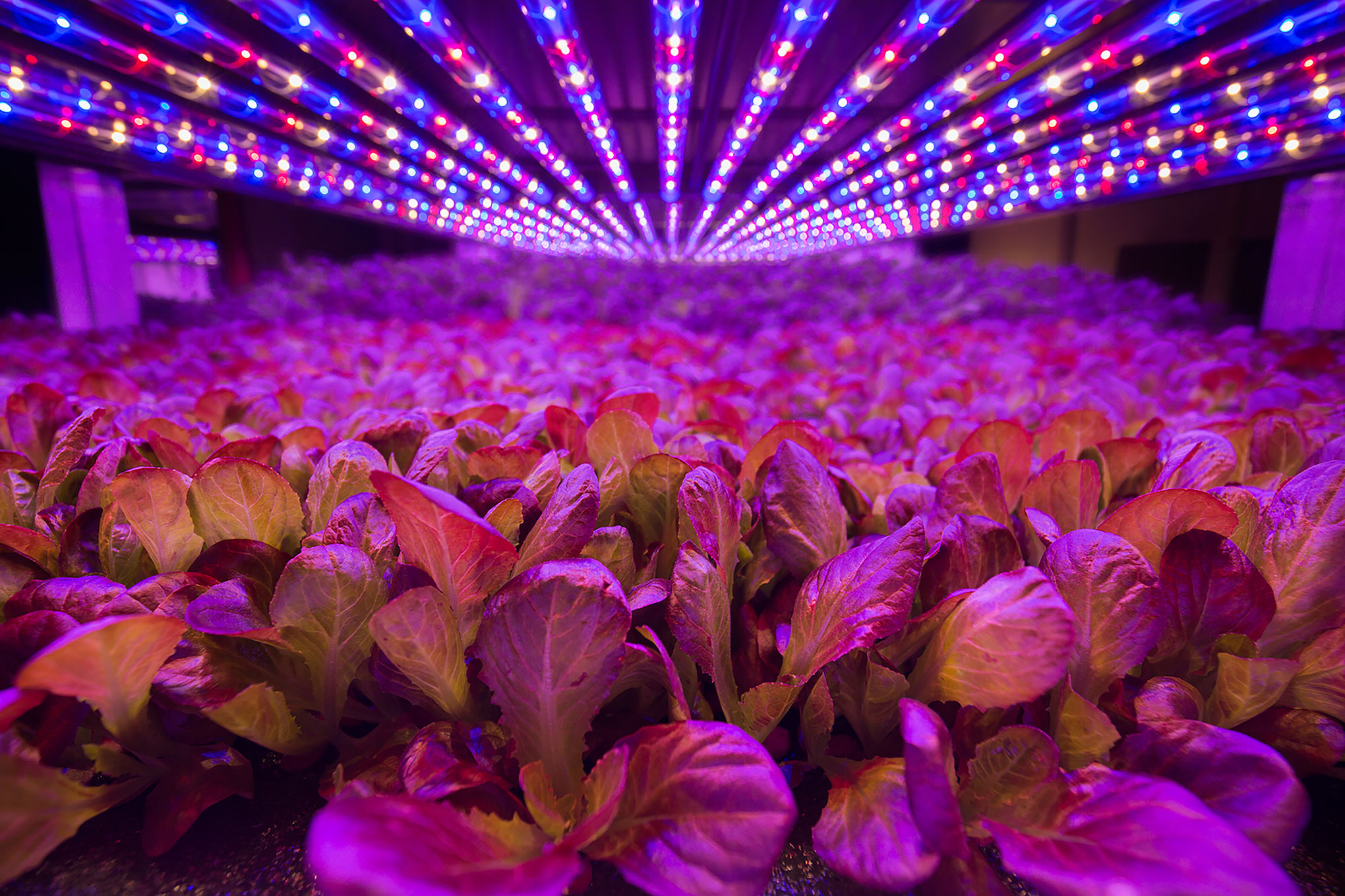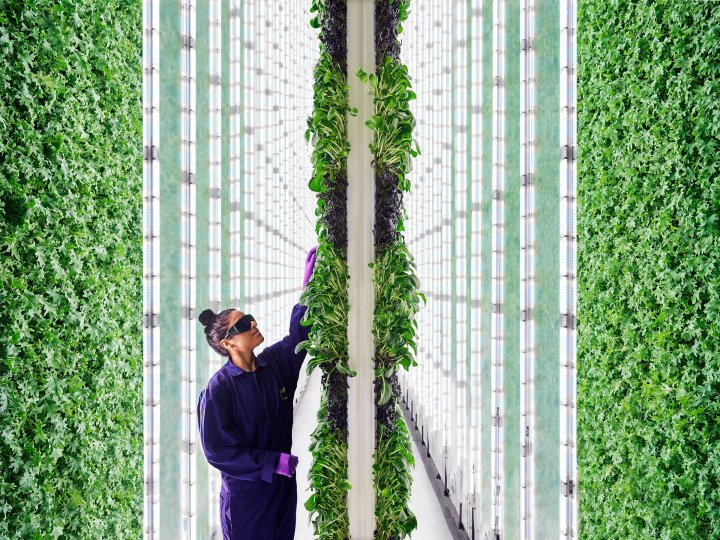Farmers have grown food in roughly the same way for thousands of years: planting seeds and watching them grow; raising animals from birth to slaughter; hoping that nature provides them the right amounts of rain and sun.
Now, entrepreneurs say they have a better idea. Agriculture in its current form is bad for the planet, they say—fields for crops and animal grazing occupy land where trees could be planted, and farming sucks up vast amounts of increasingly precious water. Why not make food in a completely different way, maybe growing lettuce in skyscrapers and creating meat from cells in a petri dish?
There is a dire need to change how food is produced. An August U.N. report prepared by more than 100 experts warned that exploitation of land and water is already putting pressure on humanity’s ability to feed itself. Those pressures will grow as the world’s population reaches 9.7 billion by 2050 and as high temperatures and floods make it more difficult to grow crops in some regions. That’s why -mission-driven entrepreneurs and funders see food tech as the ultimate investment opportunity, making money while also creating food that makes the planet a better place.
Read more of TIME's Davos 2020 coverage
The result has been billions of dollars invested in companies that promise to reinvent the food that ends up on your dinner plate. More than 47 companies making meat and dairy products from plants, including Impossible Foods and Beyond Meat, have raised $2.29 billion from venture capitalists in the past decade, one-quarter of it invested in 2019 alone, according to PitchBook, which tracks private equity and venture capital worldwide. Shares of Beyond Meat, which sells plant-based meat substitutes in grocery stores and in restaurants including Dunkin’ and TGI Fridays, are trading at roughly three times their IPO price. Nearly 40 more companies trying to grow proteins like meat and fish from cells, such as the Dutch company Mosa Meat and the San Diego firm BlueNalu, have raised $1.1 billion, almost all of that funding in the past five years, PitchBook says. While most of the investment is from venture capitalists, a handful of countries, including the Netherlands, Japan and New Zealand, have funded research into lab-grown meat.
 Solar Foods uses microbial fermentation — a process similar to producing yeast — to grow a protein resembling wheat flour from water, nutrients and carbon dioxide. Courtesy Solar Foods
Solar Foods uses microbial fermentation — a process similar to producing yeast — to grow a protein resembling wheat flour from water, nutrients and carbon dioxide. Courtesy Solar Foods Startups are thinking beyond meat too. Indoor-agriculture companies such as Plenty in California and AeroFarms in New Jersey, which grow food in tightly packed towers called vertical farms, have together raised more than $300 million. A competitor, Crop One, is partnering with Emirates Flight Catering to build a 130,000-sq.-ft. vertical farm in Dubai, which will be the world’s largest. Exo, which makes cricket protein bars and sells whole-roasted crickets, was acquired by the Aspire Food Group in 2018, and Soylent, a meal-replacement beverage, has raised more than $70 million.
“We’re on the cusp of some breakthroughs in the development of food,” said Jeff Housenbold, a partner at SoftBank who headed the firm’s investment in Plenty, a vertical farm.
But the billions of dollars being poured into startups may not change farming anytime soon. Some scientists are dubious that the many companies that say they can grow fish and steak from cells will actually be able to do so on a large scale in the next decade. Plant-based-meat companies, which have reached millions of consumers, are still scrambling to make a burger that tastes as satisfying as conventional meat. Vertical farms are expensive to run because they have to use power to provide the one thing that’s free in traditional farming: light from the sun. “The timescales of disrupting the agriculture industry are not what they are in the software industry,” says David Lobell, director of the Center on Food Security and the Environment at Stanford University. “People who have come from tech and get into ag are often frustrated by the pace of change.”
Consumers seem to be in no hurry to change their food habits, despite climate concerns. More than a decade ago, after a U.N. report found that farmed animals produced 35% to 40% of all methane emissions, newspapers including the Baltimore Sun encouraged consumers to “save the planet with a vegetarian diet.” But despite a plethora of other reports since then suggesting that eating meat contributes to climate change, meat consumption has climbed and is at an all-time high in the U.S. Global meat consumption rose by an average of 1.9% a year in the decade leading up to 2017, about twice as fast as population growth.
The money poured into food startups may just reflect wishful thinking on the part of investors who want to do something about the climate, even if consumers won’t follow. “The idea that new tech can fix a major problem that threatens the life of your grandchild is very tempting,” says Benjamin Aldes Wurgaft, the author of Meat Planet, a book about the future of food. “People hate to feel disempowered—they always want to have a lever to pull.”
The August U.N. report put a number on just how much the agricultural system contributes to climate change. From 21% to 37% of greenhouse-gas emissions caused by humans derive from agriculture and food processing, according to the report. Using land in different ways, like planting more trees instead of grazing cattle, can help mitigate climate change, said Cynthia Rosenzweig, a senior research scientist at the NASA Goddard Institute for Space Studies and one of the authors of the report. But as the world’s population grows, trees are instead being cut down to grow crops. “There’s the potential for real competition between mitigating climate change and ensuring food security,” she said.
 Leafy greens grow under LED lights in an indoor vertical farm run by Aerofarms Courtesy Aero Farms
Leafy greens grow under LED lights in an indoor vertical farm run by Aerofarms Courtesy Aero Farms Food startups are quick to tout their environmental benefits. BlueNalu cultures fish tissue from cells to help avoid overfishing at a time when demand for seafood is growing. Plenty, the vertical-farming company, says it can grow the same amount of fruits and vegetables on a space the size of a soccer goal as is usually grown on a football field, while using 1% to 5% of the water of a traditional farm. Just egg products, which are made from mung beans, require a fraction of the water and carbon dioxide needed to produce other proteins, including beef, pork, chicken and even tofu.
Food-tech companies say younger generations care more about the planet than older ones, and so will choose climate-friendly foods. Of all the consumers polled by Michigan State University who said they were already eating plant-based meat, nearly half were under 40. Besides, the companies say, their products are healthier. Conventional meat contains cholesterol and doesn’t have the fiber and complex carbohydrates that plant-based meat has, says Bruce Friedrich, executive director of the Good Food Institute, which advocates for cultured and plant-based meat. Crops grown locally in vertical farms are fresher, so people will eat more of them, and since they’re grown indoors, they don’t use pesticides, companies like Plenty say.
But traditional food companies have challenged food-tech companies at every step. “What’s hiding in your plant-based meat?” the Center for Consumer Freedom, a nonprofit supported by restaurants and food companies, asked in a full-page ad directing consumers to a website that compared plant-based meat with dog food. Chipotle CEO Brian Niccol said meat substitutes “wouldn’t fit” into Chipotle’s menu because of the “processing” required to make a plant taste like meat. Congressional lawmakers have introduced a bill supported by the U.S. Cattlemen’s Association that would require makers of plant-based and cell-cultured meat to put the word imitation on their labels, following dozens of states that have passed or introduced bills requiring plant-based-food companies to label their products “imitation meat.”
The taste and health obstacles facing plant-based-meat companies are driving more entrepreneurs to the lab-grown-meat space. But meat grown from cells might not be ready for public consumption anytime soon. The process starts with putting an animal like a cow under anesthesia, cutting open a muscle and removing a small sample of tissue. Scientists use enzymes to break that tissue down into muscle and fat cells, which are then put, along with a growth medium, into a bioreactor that looks like the fermentation tanks where beer is brewed. Then the cells multiply.
But meat has been grown from cells only on a small scale. Growth mediums, which include fetal bovine serum (essentially blood from a cow fetus), are costly, and scientists have struggled to ensure that cells grown in larger containers get enough oxygen and nutrients. No cellular-agriculture company has explained how these obstacles have been overcome, says Ricardo San Martin, research director at the Alternative Meats Lab at the University of California, Berkeley. They are very evasive, he said. “When you ask them A, they answer B.” Growing meat from cells for public consumption “is not going to happen on a large scale anytime soon,” says San Martin, “maybe even ever.”
There is almost no publicly funded research on lab-grown meat, and private companies aren’t forthcoming about their methods. But cellular--agriculture startups have been granted only a small number of patents despite their high valuations, says Babak Kusha, a patent lawyer at -Kilpatrick Townsend.
Scaling obstacles also exist in vertical farming, and two vertical-farming startups already went out of business in 2016 and 2017. Plants need a tremendous amount of light to photosynthesize, about 50 times more than humans need to see, says Neil Mattson, a professor of plant science at Cornell University who is conducting a large-scale study of vertical farms. Vertical farms use LED lights to grow plants, and though the costs of LED lights have fallen significantly in recent years, lettuce grown in vertical farms in New York and Chicago was twice as expensive as lettuce grown in the California fields and shipped to those cities, according to a study co-authored by Mattson. Labor was costlier in New York and Chicago, and the structures that housed the vertical farms were expensive to build and maintain. Vertical-farm companies are experimenting with using solar and wind power to reduce their energy bills, but Mattson believes vertical farms will be cost-effective only when renewable-energy prices fall.
Food-tech companies say big change can happen now. In a lab in Boston looking out onto a dry dock where ships are repaired, Motif FoodWorks is preparing to ramp up production of animal-free ingredients that make plant-based food taste better. With the help of advances in synthetic biology, Motif inserts genes into yeast microbes to create things like animal-free milk-protein isolates that could make almond milk creamier.
Motif’s lab uses computer-assisted machines to tinker with ingredients in test tubes the size of pencils, a scene far removed from that of a muddy dairy farm in rural America, where big companies currently get milk-protein isolates from cow’s milk. But Michael Leonard, the chief technology officer at Motif, says it’s the future of food. The cost of sequencing genomes has fallen dramatically, and computers have become more adept at scanning genomes to find alternative sources of protein, he says. Motif plans to have its first products ready to sell to food giants by 2021, when consumers will have become much more comfortable with the intersection of technology and food. “I think what we’ll see over time with the undeniable reality of population growth is the need to do more with less,” he says. “And I think plant-based eating can really help to bring that into balance.”
TIME's Davos 2020 issue was produced in partnership with the World Economic Forum.

















